BUSN20017 Term One: Enhancing Internal Communication at Data Solutions
VerifiedAdded on 2023/06/14
|7
|1247
|389
Report
AI Summary
This assignment presents a memo addressing the critical need for improved internal communication processes within Data Solutions. It begins by outlining the objectives and background, emphasizing the importance of effective communication channels for organizational coherence and goal achievement. The memo details a communication audit process, including key steps such as determining audit areas, choosing research methods (interviews, questionnaires, media analysis), collecting feedback from customers, community, and employees, and conducting a SWOT analysis. It highlights problems such as employees' inability to choose appropriate communication channels, limited internal communication inclusivity, and ineffective inter-organizational meetings. Action steps to solve these problems are suggested, including seminars on communication channels, emphasizing information sharing, and implementing follow-up meetings. The memo concludes by reiterating the importance of positive communication habits for employee collaboration, job satisfaction, and overall organizational success. The document is available on Desklib, a platform offering a wide range of study resources for students.
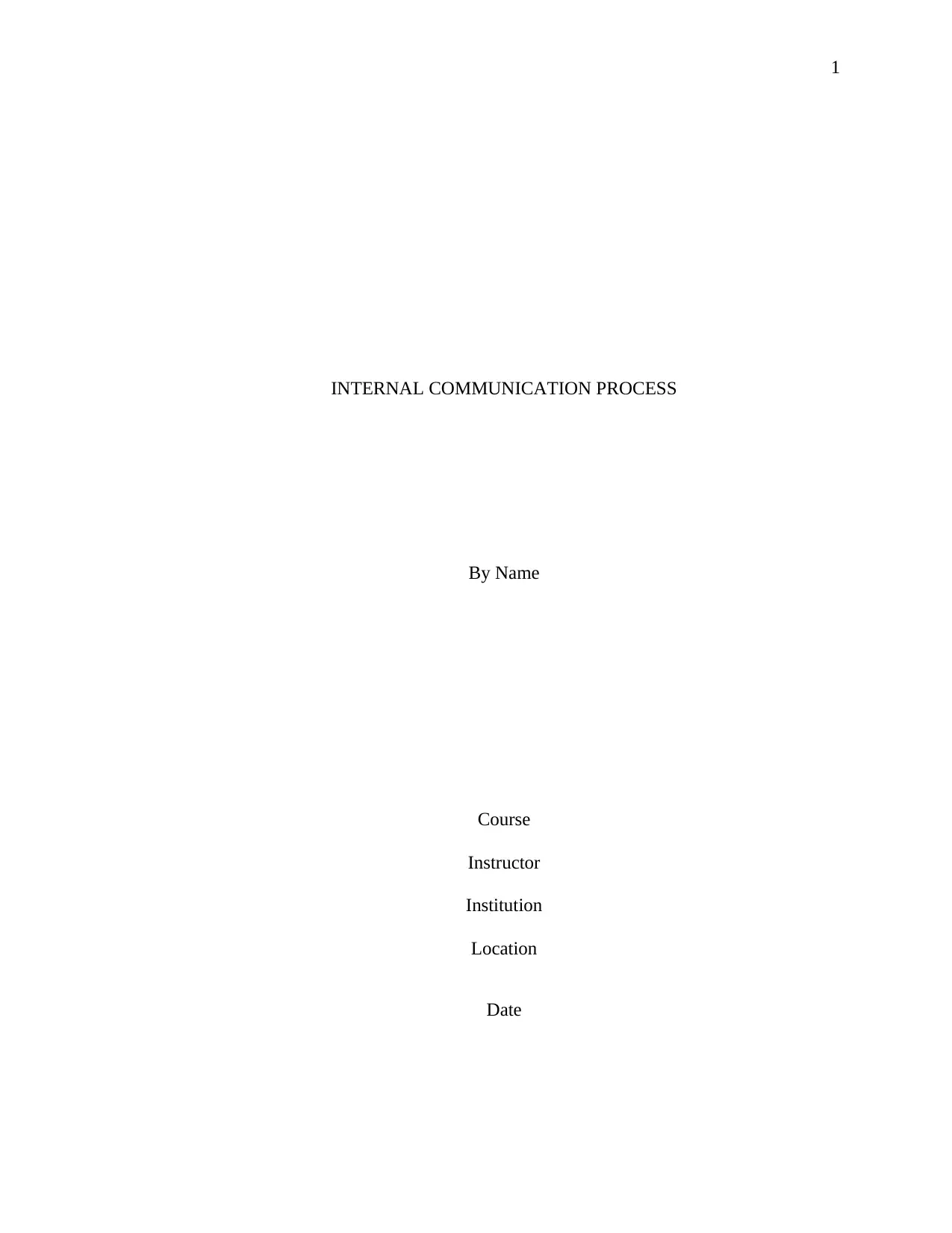
1
INTERNAL COMMUNICATION PROCESS
By Name
Course
Instructor
Institution
Location
Date
INTERNAL COMMUNICATION PROCESS
By Name
Course
Instructor
Institution
Location
Date
Paraphrase This Document
Need a fresh take? Get an instant paraphrase of this document with our AI Paraphraser
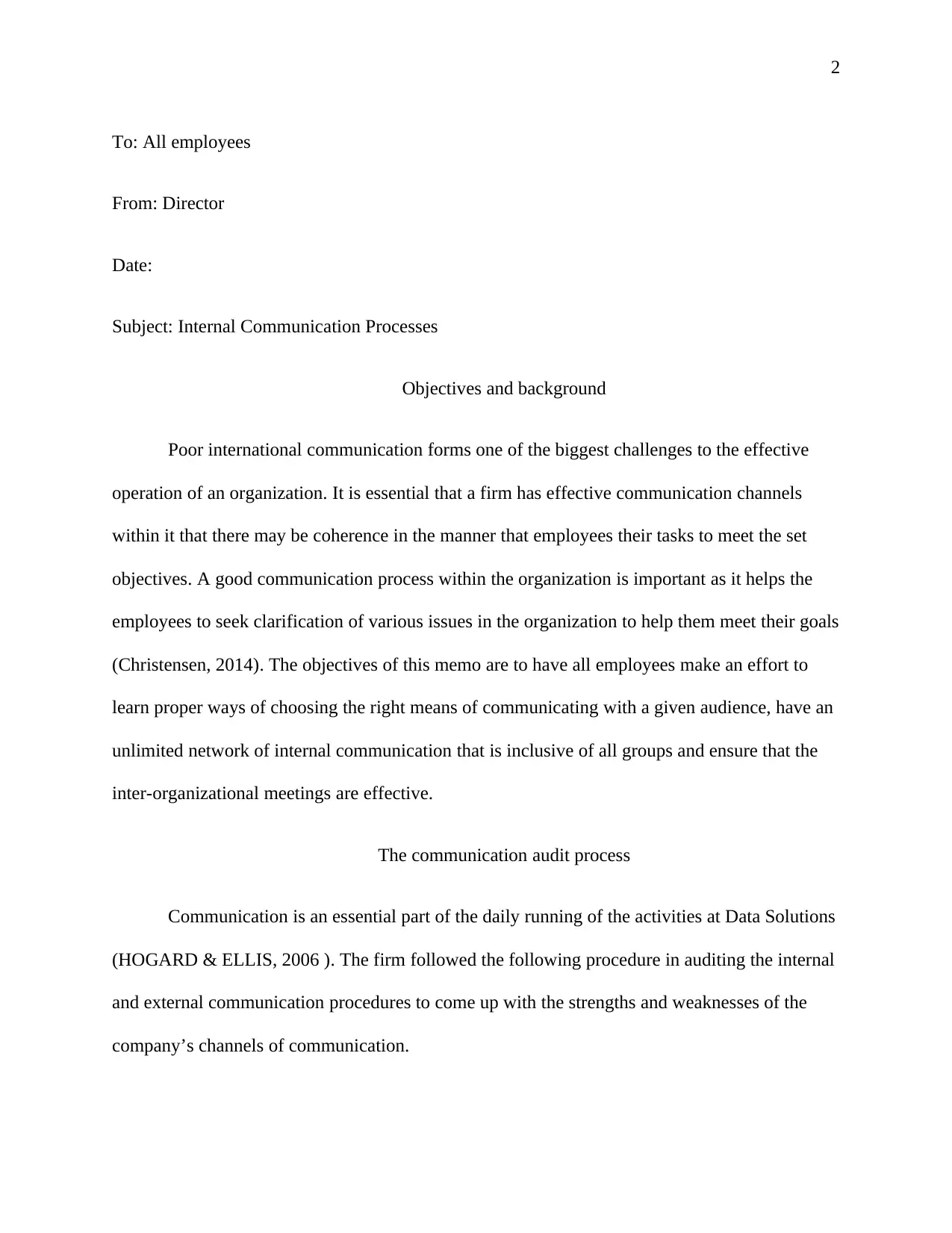
2
To: All employees
From: Director
Date:
Subject: Internal Communication Processes
Objectives and background
Poor international communication forms one of the biggest challenges to the effective
operation of an organization. It is essential that a firm has effective communication channels
within it that there may be coherence in the manner that employees their tasks to meet the set
objectives. A good communication process within the organization is important as it helps the
employees to seek clarification of various issues in the organization to help them meet their goals
(Christensen, 2014). The objectives of this memo are to have all employees make an effort to
learn proper ways of choosing the right means of communicating with a given audience, have an
unlimited network of internal communication that is inclusive of all groups and ensure that the
inter-organizational meetings are effective.
The communication audit process
Communication is an essential part of the daily running of the activities at Data Solutions
(HOGARD & ELLIS, 2006 ). The firm followed the following procedure in auditing the internal
and external communication procedures to come up with the strengths and weaknesses of the
company’s channels of communication.
To: All employees
From: Director
Date:
Subject: Internal Communication Processes
Objectives and background
Poor international communication forms one of the biggest challenges to the effective
operation of an organization. It is essential that a firm has effective communication channels
within it that there may be coherence in the manner that employees their tasks to meet the set
objectives. A good communication process within the organization is important as it helps the
employees to seek clarification of various issues in the organization to help them meet their goals
(Christensen, 2014). The objectives of this memo are to have all employees make an effort to
learn proper ways of choosing the right means of communicating with a given audience, have an
unlimited network of internal communication that is inclusive of all groups and ensure that the
inter-organizational meetings are effective.
The communication audit process
Communication is an essential part of the daily running of the activities at Data Solutions
(HOGARD & ELLIS, 2006 ). The firm followed the following procedure in auditing the internal
and external communication procedures to come up with the strengths and weaknesses of the
company’s channels of communication.
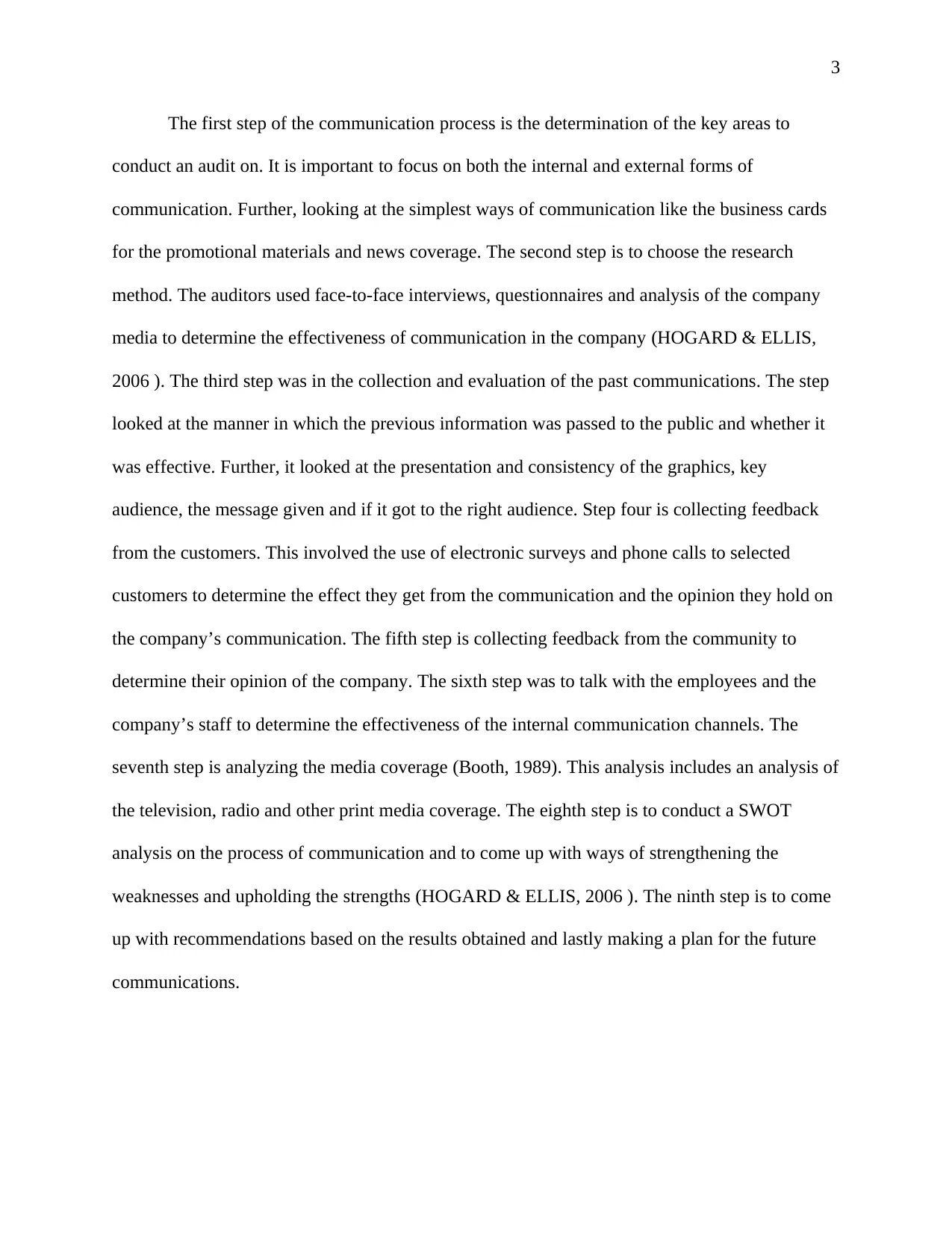
3
The first step of the communication process is the determination of the key areas to
conduct an audit on. It is important to focus on both the internal and external forms of
communication. Further, looking at the simplest ways of communication like the business cards
for the promotional materials and news coverage. The second step is to choose the research
method. The auditors used face-to-face interviews, questionnaires and analysis of the company
media to determine the effectiveness of communication in the company (HOGARD & ELLIS,
2006 ). The third step was in the collection and evaluation of the past communications. The step
looked at the manner in which the previous information was passed to the public and whether it
was effective. Further, it looked at the presentation and consistency of the graphics, key
audience, the message given and if it got to the right audience. Step four is collecting feedback
from the customers. This involved the use of electronic surveys and phone calls to selected
customers to determine the effect they get from the communication and the opinion they hold on
the company’s communication. The fifth step is collecting feedback from the community to
determine their opinion of the company. The sixth step was to talk with the employees and the
company’s staff to determine the effectiveness of the internal communication channels. The
seventh step is analyzing the media coverage (Booth, 1989). This analysis includes an analysis of
the television, radio and other print media coverage. The eighth step is to conduct a SWOT
analysis on the process of communication and to come up with ways of strengthening the
weaknesses and upholding the strengths (HOGARD & ELLIS, 2006 ). The ninth step is to come
up with recommendations based on the results obtained and lastly making a plan for the future
communications.
The first step of the communication process is the determination of the key areas to
conduct an audit on. It is important to focus on both the internal and external forms of
communication. Further, looking at the simplest ways of communication like the business cards
for the promotional materials and news coverage. The second step is to choose the research
method. The auditors used face-to-face interviews, questionnaires and analysis of the company
media to determine the effectiveness of communication in the company (HOGARD & ELLIS,
2006 ). The third step was in the collection and evaluation of the past communications. The step
looked at the manner in which the previous information was passed to the public and whether it
was effective. Further, it looked at the presentation and consistency of the graphics, key
audience, the message given and if it got to the right audience. Step four is collecting feedback
from the customers. This involved the use of electronic surveys and phone calls to selected
customers to determine the effect they get from the communication and the opinion they hold on
the company’s communication. The fifth step is collecting feedback from the community to
determine their opinion of the company. The sixth step was to talk with the employees and the
company’s staff to determine the effectiveness of the internal communication channels. The
seventh step is analyzing the media coverage (Booth, 1989). This analysis includes an analysis of
the television, radio and other print media coverage. The eighth step is to conduct a SWOT
analysis on the process of communication and to come up with ways of strengthening the
weaknesses and upholding the strengths (HOGARD & ELLIS, 2006 ). The ninth step is to come
up with recommendations based on the results obtained and lastly making a plan for the future
communications.
⊘ This is a preview!⊘
Do you want full access?
Subscribe today to unlock all pages.

Trusted by 1+ million students worldwide
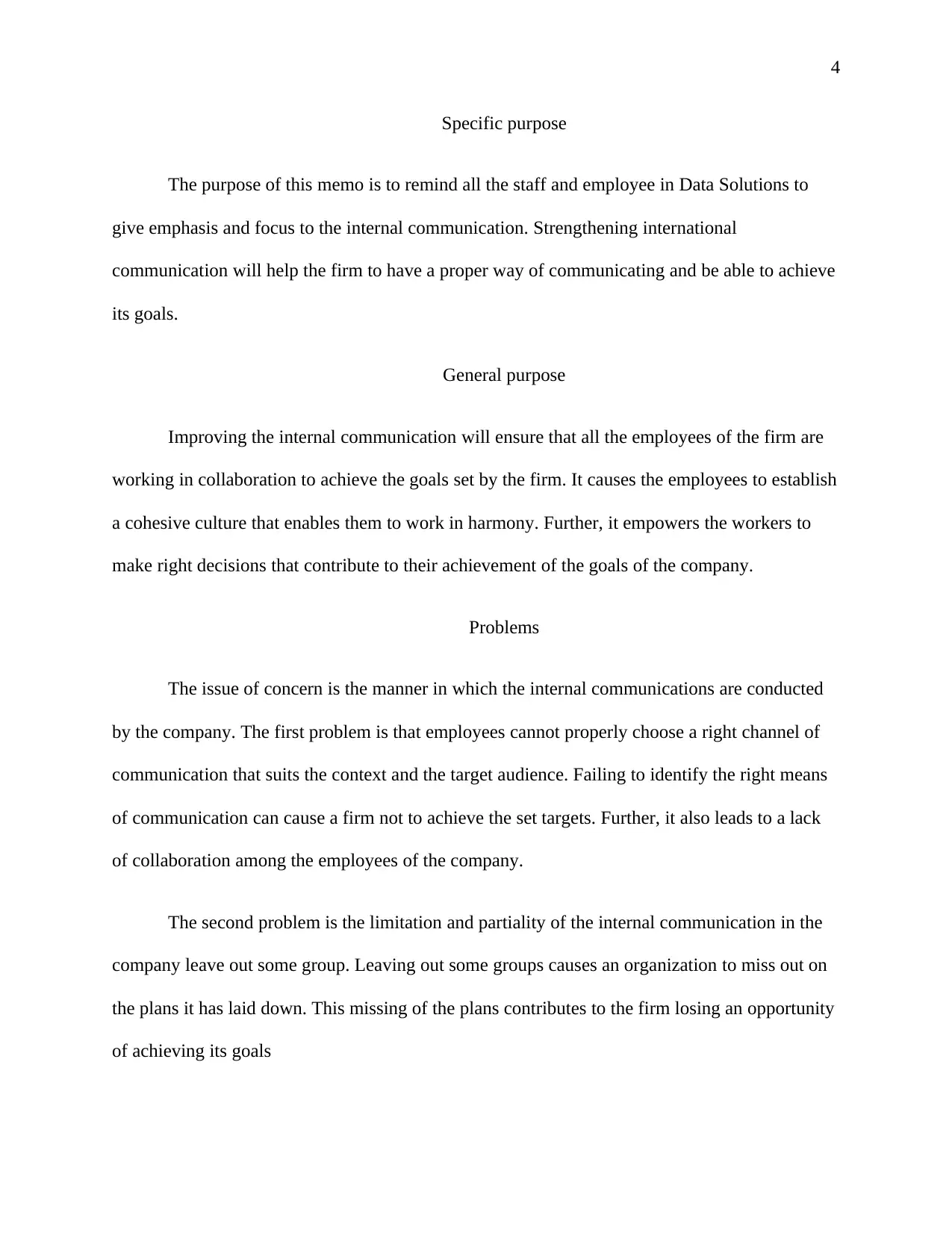
4
Specific purpose
The purpose of this memo is to remind all the staff and employee in Data Solutions to
give emphasis and focus to the internal communication. Strengthening international
communication will help the firm to have a proper way of communicating and be able to achieve
its goals.
General purpose
Improving the internal communication will ensure that all the employees of the firm are
working in collaboration to achieve the goals set by the firm. It causes the employees to establish
a cohesive culture that enables them to work in harmony. Further, it empowers the workers to
make right decisions that contribute to their achievement of the goals of the company.
Problems
The issue of concern is the manner in which the internal communications are conducted
by the company. The first problem is that employees cannot properly choose a right channel of
communication that suits the context and the target audience. Failing to identify the right means
of communication can cause a firm not to achieve the set targets. Further, it also leads to a lack
of collaboration among the employees of the company.
The second problem is the limitation and partiality of the internal communication in the
company leave out some group. Leaving out some groups causes an organization to miss out on
the plans it has laid down. This missing of the plans contributes to the firm losing an opportunity
of achieving its goals
Specific purpose
The purpose of this memo is to remind all the staff and employee in Data Solutions to
give emphasis and focus to the internal communication. Strengthening international
communication will help the firm to have a proper way of communicating and be able to achieve
its goals.
General purpose
Improving the internal communication will ensure that all the employees of the firm are
working in collaboration to achieve the goals set by the firm. It causes the employees to establish
a cohesive culture that enables them to work in harmony. Further, it empowers the workers to
make right decisions that contribute to their achievement of the goals of the company.
Problems
The issue of concern is the manner in which the internal communications are conducted
by the company. The first problem is that employees cannot properly choose a right channel of
communication that suits the context and the target audience. Failing to identify the right means
of communication can cause a firm not to achieve the set targets. Further, it also leads to a lack
of collaboration among the employees of the company.
The second problem is the limitation and partiality of the internal communication in the
company leave out some group. Leaving out some groups causes an organization to miss out on
the plans it has laid down. This missing of the plans contributes to the firm losing an opportunity
of achieving its goals
Paraphrase This Document
Need a fresh take? Get an instant paraphrase of this document with our AI Paraphraser
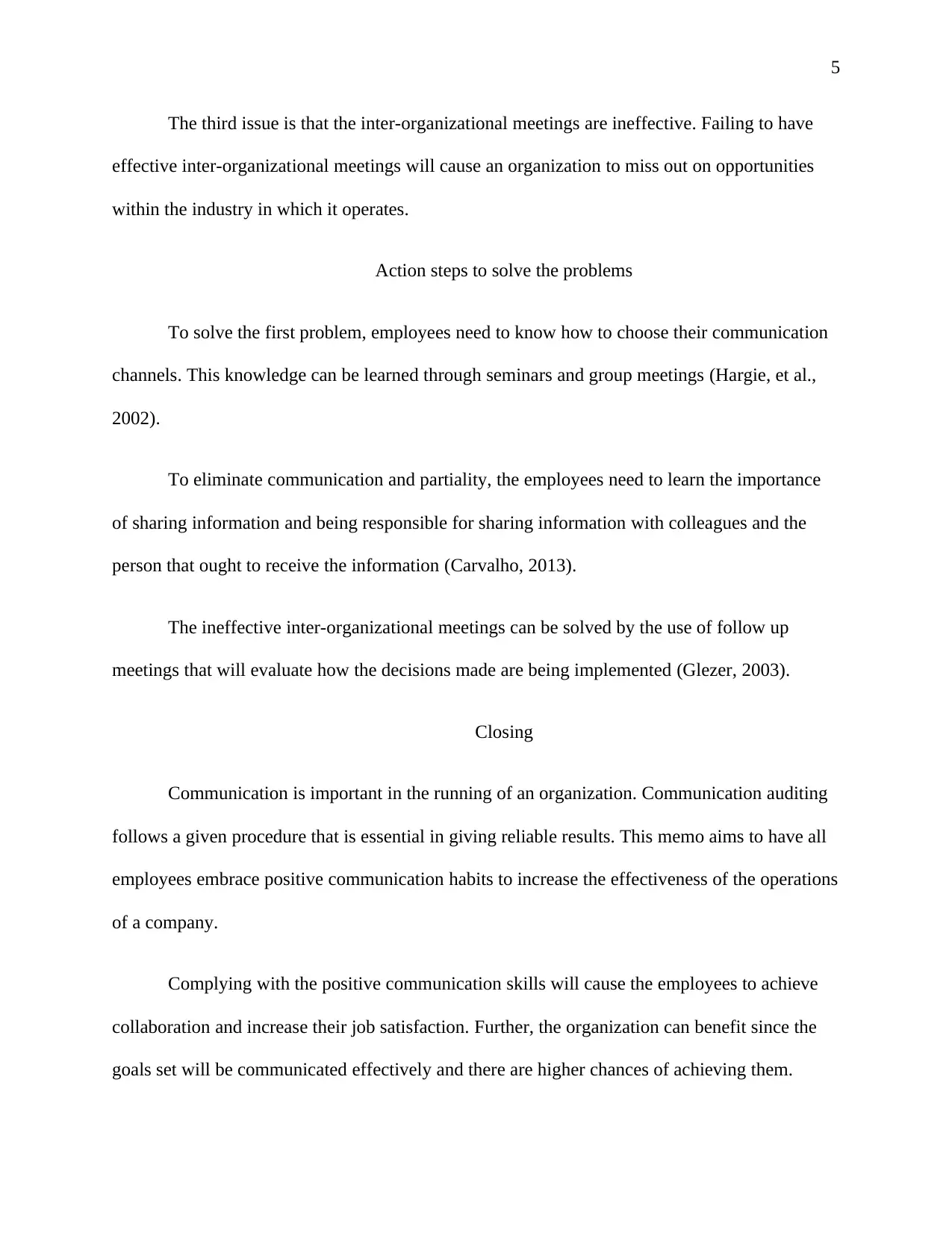
5
The third issue is that the inter-organizational meetings are ineffective. Failing to have
effective inter-organizational meetings will cause an organization to miss out on opportunities
within the industry in which it operates.
Action steps to solve the problems
To solve the first problem, employees need to know how to choose their communication
channels. This knowledge can be learned through seminars and group meetings (Hargie, et al.,
2002).
To eliminate communication and partiality, the employees need to learn the importance
of sharing information and being responsible for sharing information with colleagues and the
person that ought to receive the information (Carvalho, 2013).
The ineffective inter-organizational meetings can be solved by the use of follow up
meetings that will evaluate how the decisions made are being implemented (Glezer, 2003).
Closing
Communication is important in the running of an organization. Communication auditing
follows a given procedure that is essential in giving reliable results. This memo aims to have all
employees embrace positive communication habits to increase the effectiveness of the operations
of a company.
Complying with the positive communication skills will cause the employees to achieve
collaboration and increase their job satisfaction. Further, the organization can benefit since the
goals set will be communicated effectively and there are higher chances of achieving them.
The third issue is that the inter-organizational meetings are ineffective. Failing to have
effective inter-organizational meetings will cause an organization to miss out on opportunities
within the industry in which it operates.
Action steps to solve the problems
To solve the first problem, employees need to know how to choose their communication
channels. This knowledge can be learned through seminars and group meetings (Hargie, et al.,
2002).
To eliminate communication and partiality, the employees need to learn the importance
of sharing information and being responsible for sharing information with colleagues and the
person that ought to receive the information (Carvalho, 2013).
The ineffective inter-organizational meetings can be solved by the use of follow up
meetings that will evaluate how the decisions made are being implemented (Glezer, 2003).
Closing
Communication is important in the running of an organization. Communication auditing
follows a given procedure that is essential in giving reliable results. This memo aims to have all
employees embrace positive communication habits to increase the effectiveness of the operations
of a company.
Complying with the positive communication skills will cause the employees to achieve
collaboration and increase their job satisfaction. Further, the organization can benefit since the
goals set will be communicated effectively and there are higher chances of achieving them.

6
Director
Email: director@datasolutions.com
Director
Email: director@datasolutions.com
⊘ This is a preview!⊘
Do you want full access?
Subscribe today to unlock all pages.

Trusted by 1+ million students worldwide
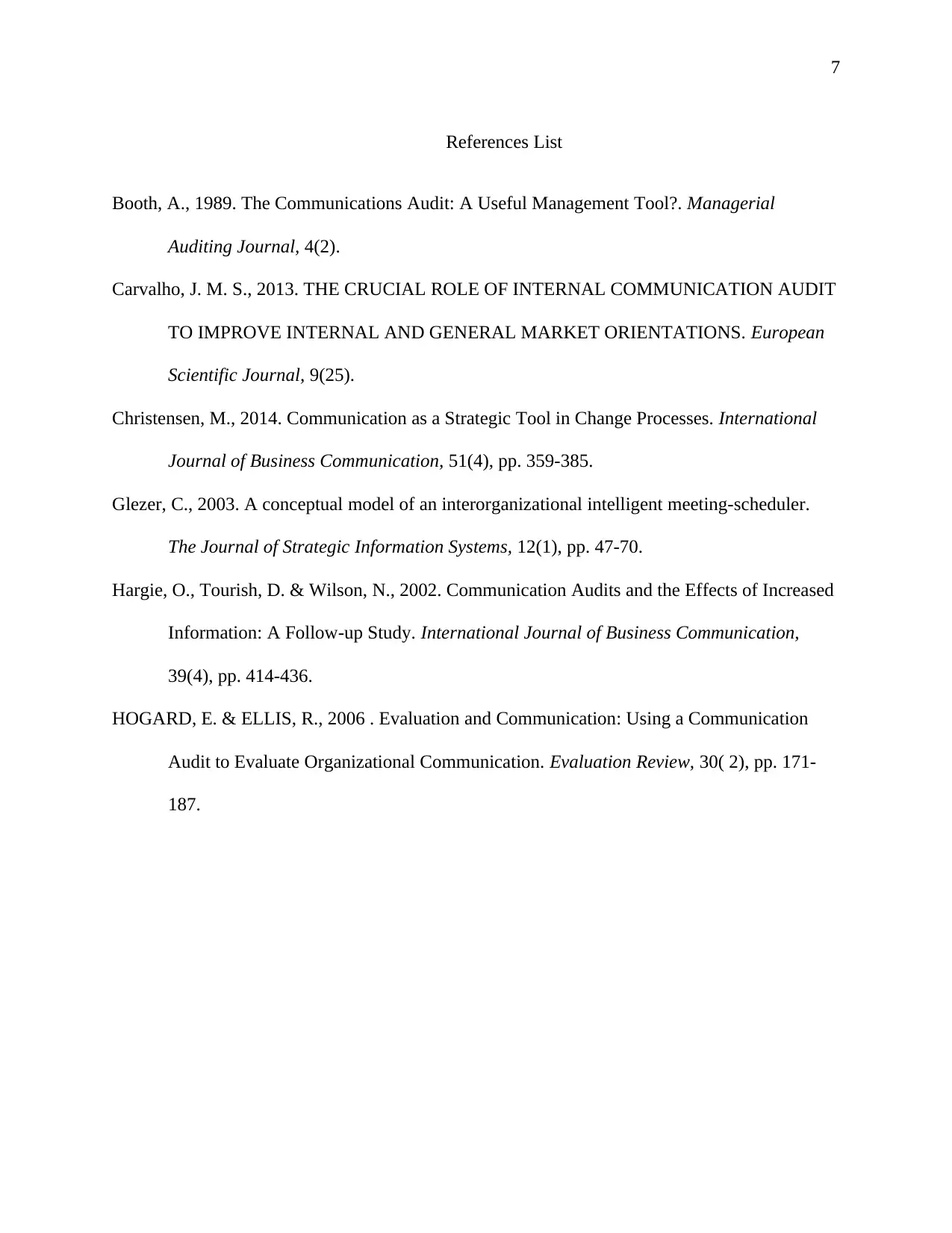
7
References List
Booth, A., 1989. The Communications Audit: A Useful Management Tool?. Managerial
Auditing Journal, 4(2).
Carvalho, J. M. S., 2013. THE CRUCIAL ROLE OF INTERNAL COMMUNICATION AUDIT
TO IMPROVE INTERNAL AND GENERAL MARKET ORIENTATIONS. European
Scientific Journal, 9(25).
Christensen, M., 2014. Communication as a Strategic Tool in Change Processes. International
Journal of Business Communication, 51(4), pp. 359-385.
Glezer, C., 2003. A conceptual model of an interorganizational intelligent meeting-scheduler.
The Journal of Strategic Information Systems, 12(1), pp. 47-70.
Hargie, O., Tourish, D. & Wilson, N., 2002. Communication Audits and the Effects of Increased
Information: A Follow-up Study. International Journal of Business Communication,
39(4), pp. 414-436.
HOGARD, E. & ELLIS, R., 2006 . Evaluation and Communication: Using a Communication
Audit to Evaluate Organizational Communication. Evaluation Review, 30( 2), pp. 171-
187.
References List
Booth, A., 1989. The Communications Audit: A Useful Management Tool?. Managerial
Auditing Journal, 4(2).
Carvalho, J. M. S., 2013. THE CRUCIAL ROLE OF INTERNAL COMMUNICATION AUDIT
TO IMPROVE INTERNAL AND GENERAL MARKET ORIENTATIONS. European
Scientific Journal, 9(25).
Christensen, M., 2014. Communication as a Strategic Tool in Change Processes. International
Journal of Business Communication, 51(4), pp. 359-385.
Glezer, C., 2003. A conceptual model of an interorganizational intelligent meeting-scheduler.
The Journal of Strategic Information Systems, 12(1), pp. 47-70.
Hargie, O., Tourish, D. & Wilson, N., 2002. Communication Audits and the Effects of Increased
Information: A Follow-up Study. International Journal of Business Communication,
39(4), pp. 414-436.
HOGARD, E. & ELLIS, R., 2006 . Evaluation and Communication: Using a Communication
Audit to Evaluate Organizational Communication. Evaluation Review, 30( 2), pp. 171-
187.
1 out of 7
Related Documents
Your All-in-One AI-Powered Toolkit for Academic Success.
+13062052269
info@desklib.com
Available 24*7 on WhatsApp / Email
![[object Object]](/_next/static/media/star-bottom.7253800d.svg)
Unlock your academic potential
Copyright © 2020–2025 A2Z Services. All Rights Reserved. Developed and managed by ZUCOL.



